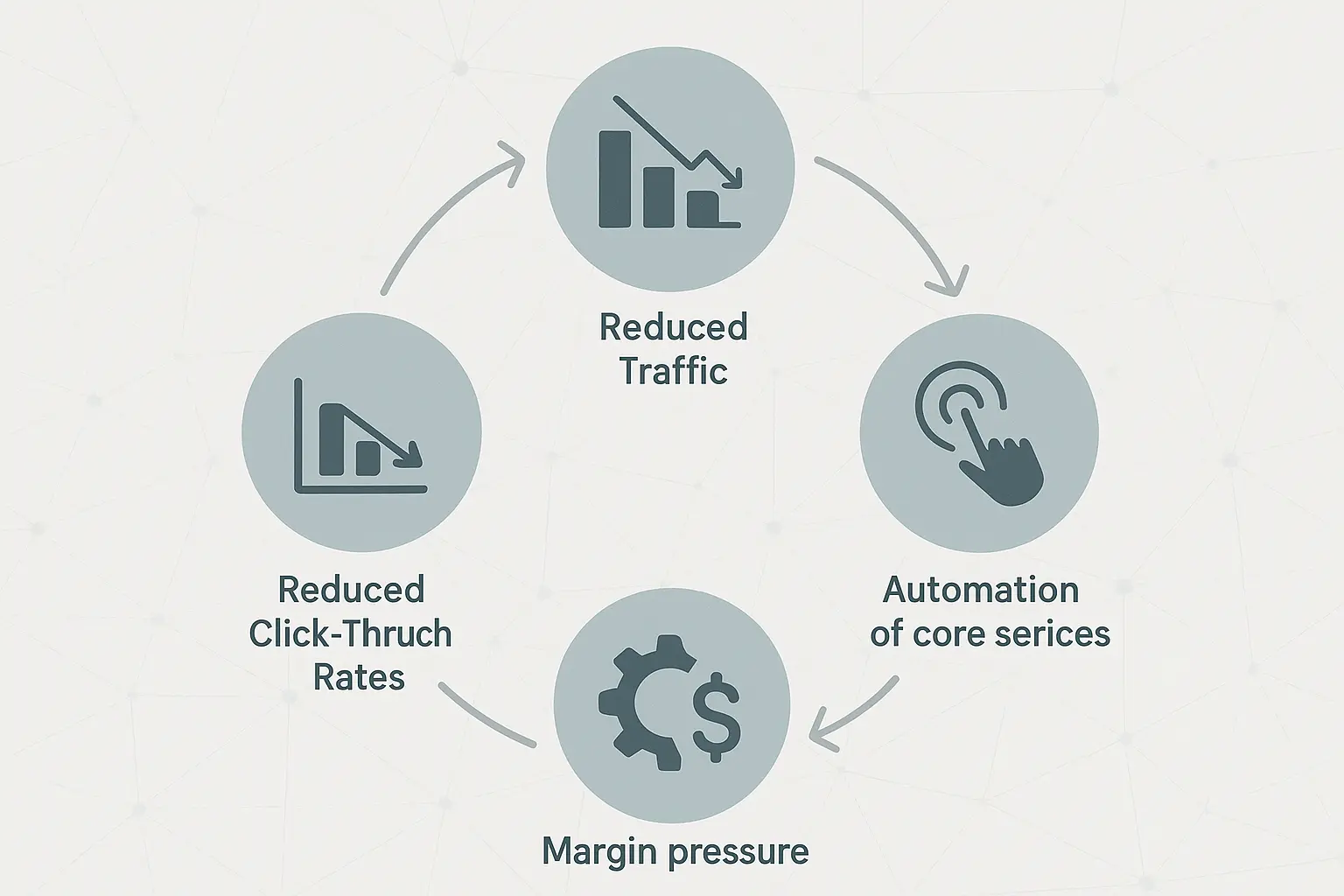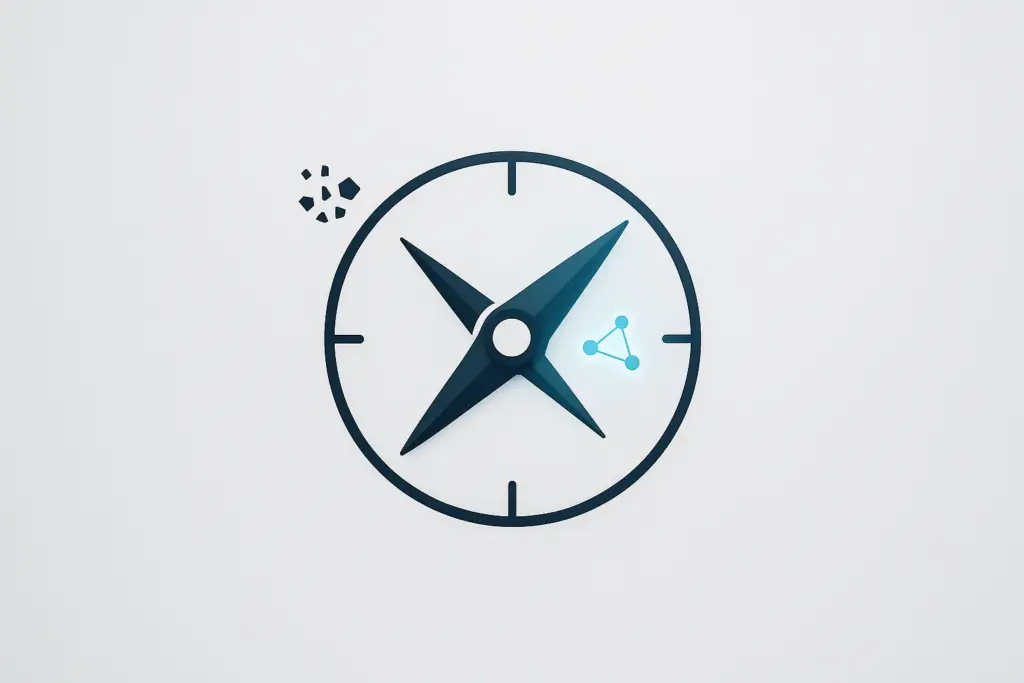Every agency leader is having the same conversation. It’s a mix of excitement and anxiety about AI, a sense that the ground is shifting beneath your feet. You see the headlines and competitor case studies, but the practical path forward feels buried under a mountain of tactical advice and tool listicles.
The core challenge isn’t learning to use another AI content generator; it’s fundamentally re-evaluating your agency’s business model. And while an IAB report finds that only 30% of agencies have fully integrated AI across their campaign lifecycle, the pressure to adapt is already here. Your clients are asking questions, your team is looking for direction, and the very nature of search is changing.
This isn’t another guide on “10 AI tools to try.” This is a strategic framework for agency leaders—a clear-eyed look at the real risks and a structured approach to seizing the massive opportunities ahead. It’s time to move from tactical reaction to strategic action.
The Elephant in the Room: Decoding the Strategic Risks of AI-Driven Search
Before we explore the opportunities, we have to address the fear. It’s real, and it’s valid. Ignoring the threats AI-driven search poses to traditional agency revenue streams would be a critical mistake. Understanding them is the first step toward building a resilient, future-proof business.
Understanding the interconnected risks of AI-driven search empowers agency leaders to safeguard their business models proactively.
Here are the primary risks you need to be planning for today:
Threat 1: Traffic Commoditization and the End of the Ten Blue Links
Google’s Search Generative Experience (SGE) and AI Overviews are designed to answer user queries directly in the SERP. The result is that the traditional model of earning a click by ranking in the top positions is under threat. When users get their answers without leaving Google, the organic traffic you fought so hard to win for your clients could evaporate, making it harder to prove the value of classic SEO.
Threat 2: Automation of Core, Billable Services
Many foundational tasks agencies bill for—keyword research, bid management, performance reporting, and even technical audits—are becoming increasingly automated. As AI handles these tasks more efficiently, clients will begin to question paying premium agency fees for work a machine can do instantly. Data from Sixth City Marketing shows 54% of companies using AI automation are already seeing significant cost savings, and your clients expect you to deliver similar efficiencies.
Threat 3: Client Pressure on Margins
As clients become more aware of AI’s capabilities, they will expect more for less. They’ll want to see how you’re leveraging AI to reduce costs and improve performance, putting downward pressure on retainers and project fees unless you can clearly articulate a new, higher-level value proposition that goes beyond simple execution.
The AI Opportunity Matrix: A Framework for New Agency Revenue
Acknowledging the risks isn’t about pessimism; it’s about preparation. With a clear view of the challenges, you can pivot your agency’s offerings. Instead of simply adding AI tools to old services, you can build entirely new, defensible revenue streams.
The AI Opportunity Matrix is a simple framework to help you categorize and prioritize your next move.
The AI Opportunity Matrix simplifies complex strategic choices, helping agency leaders map out new revenue streams amid the disruption from AI.
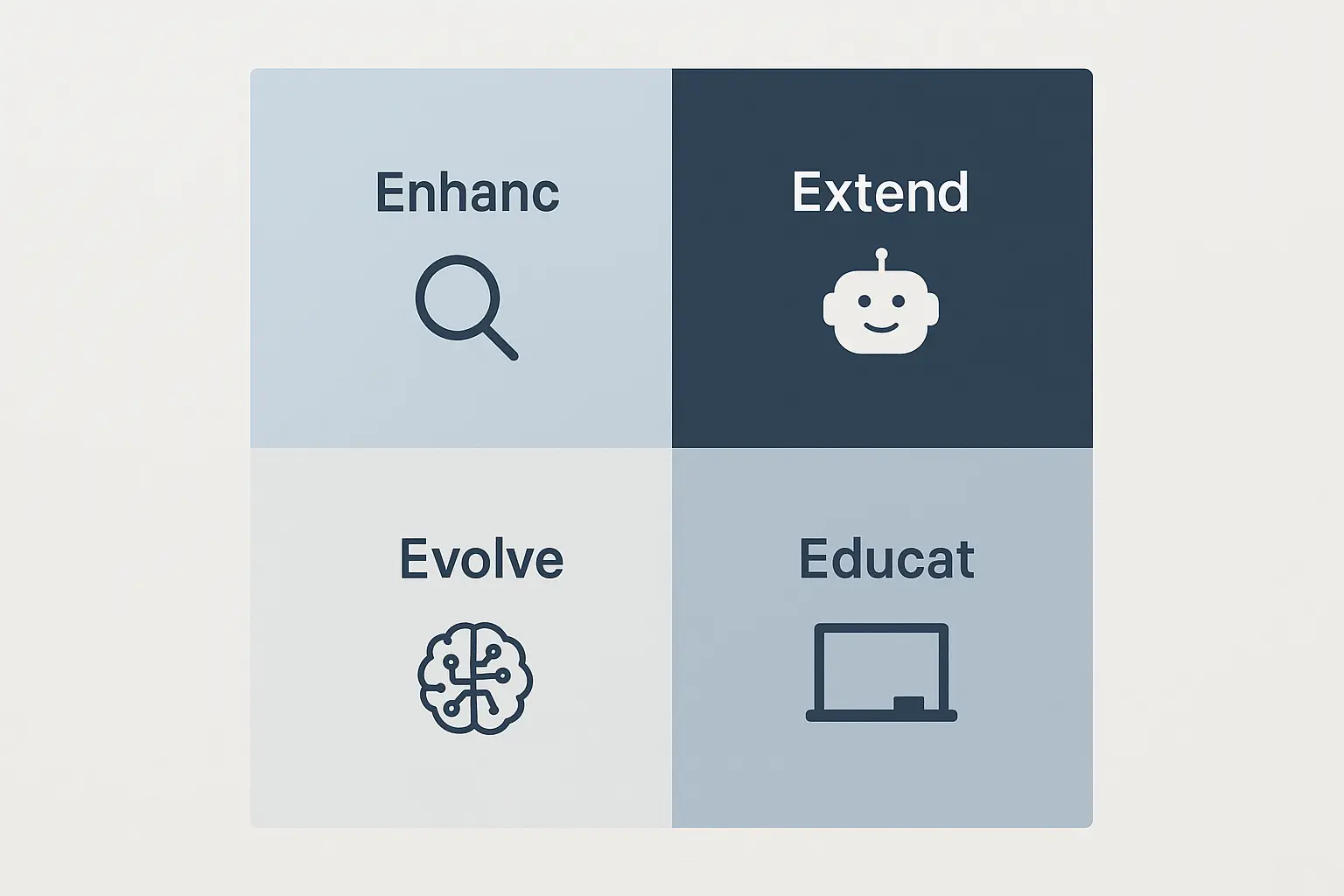
Quadrant 1: Enhance
This is the most immediate and accessible opportunity, focused on using AI to make your current services faster, smarter, and more efficient.
Examples: Using AI for predictive analytics in CRO, generating hyper-efficient content briefs, or automating performance reporting.
Goal: Improve margins, deliver better results on existing services, and free up your team for more strategic work.
Quadrant 2: Extend
Here, you launch services that are adjacent to your core offerings, powered by new AI capabilities.
Examples: A web design agency offering AI-powered chatbot development; a social media agency providing AI-driven sentiment analysis and crisis monitoring.
Goal: Expand your share of wallet with existing clients by solving new problems for them.
Quadrant 3: Evolve
This is where true, long-term competitive advantage is built. You’re creating entirely new, AI-native service lines that didn’t exist before—the future of search-focused agencies.
Examples: Offering AI-Ready SEO services focused on entity optimization and structured data for SGE, providing AI readiness consulting to help clients structure their internal data, or developing omnichannel growth strategies that integrate signals from search, social, and paid.
Goal: Position your agency as an indispensable strategic partner and create high-margin services that are difficult to commoditize.
Quadrant 4: Educate
Your expertise is a valuable asset. Monetize it by helping your clients navigate this transition.
Examples: Running paid workshops on AI for marketing teams, developing C-suite briefings on the impact of SGE, or creating proprietary training programs.
Goal: Establish your agency as a thought leader and create a new, high-margin revenue stream.
Your 9-Month Roadmap to Becoming an AI-Powered Agency
Transformation doesn’t happen overnight. A phased approach lets you build momentum, secure early wins, and adapt your strategy without disrupting your entire operation.
A phased roadmap guides agency leaders through manageable steps to confidently evolve their services and thrive in the AI-first era.
Phase 1 (Months 0-3): Internal Education and Enhancement
Focus: Build internal competency and find immediate efficiencies.
Actions:
- Appoint an “AI Champion” to lead research and adoption.
- Invest in training for your team on core AI concepts and tools.
- Pilot AI tools to enhance existing workflows (Quadrant 1), like using an AI-powered SEO automation platform for audits and reporting.
- Measure efficiency gains and build internal case studies.
Phase 2 (Months 3-9): Pilot New Services
Focus: Test and refine your new AI-driven offerings with trusted clients.
Actions:
- Identify 2-3 clients who are good candidates for a pilot program.
- Develop a beta version of a new service from the “Extend” or “Evolve” quadrants.
- Co-create the service with the pilot clients, gathering feedback and refining your process.
- Document results meticulously to build powerful case studies.
Phase 3 (Months 9+): Scale and Reposition
Focus: Roll out your proven services to the broader market and update your agency’s positioning.
Actions:
- Formalize your new service offerings with clear pricing and deliverables.
- Update your website, sales decks, and marketing materials to reflect your new AI capabilities.
- Launch a thought leadership campaign (webinars, whitepapers) based on your pilot program results to attract new, high-value clients.
The Critical Decision: Building In-House vs. Partnering for Execution
As you implement this roadmap, you’ll face a critical decision: should you build these new AI capabilities in-house or partner with a specialist to handle the execution? This is the most important strategic choice you’ll make in your AI transition.
Building an in-house team is tempting—it promises full control. But it comes with significant downsides: high costs, a fierce war for talent, and a slow, disruptive ramp-up period. For most agencies, there’s a faster, smarter path.
Comparing the build-versus-partner approach helps agency leaders evaluate the most efficient, lowest-risk strategy for adopting AI capabilities.
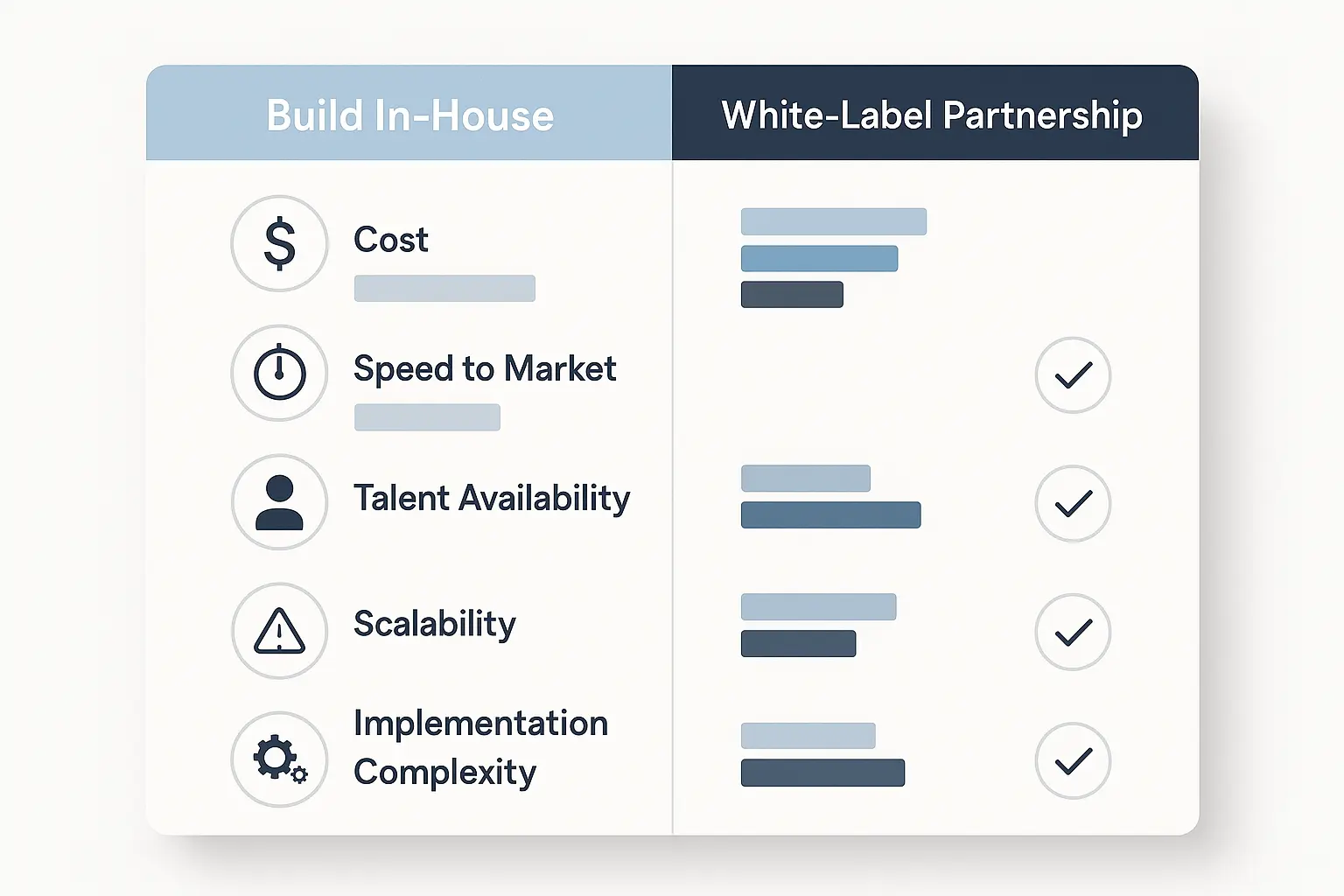
Partnering with a white-label execution specialist allows you to instantly bolt on advanced capabilities without the operational drag. It’s the ultimate low-risk growth strategy.
- Speed-to-Market: You can begin offering sophisticated, AI-driven SEO and omnichannel services in weeks, not years.
- Cost-Efficiency: You avoid the six-figure salaries of AI specialists and the high cost of software development, converting a massive capital expenditure into a predictable operational cost.
- Scalability: A white-label SEO partner allows you to scale your delivery capacity up or down on demand, so you can take on more clients without hiring.
- Focus on Your Core: You and your team can focus on what you do best—client strategy and relationships—while the complex execution happens invisibly in the background.
This model lets you leapfrog the competition, offering the advanced services of a massive agency with the agility and client focus of a boutique firm.
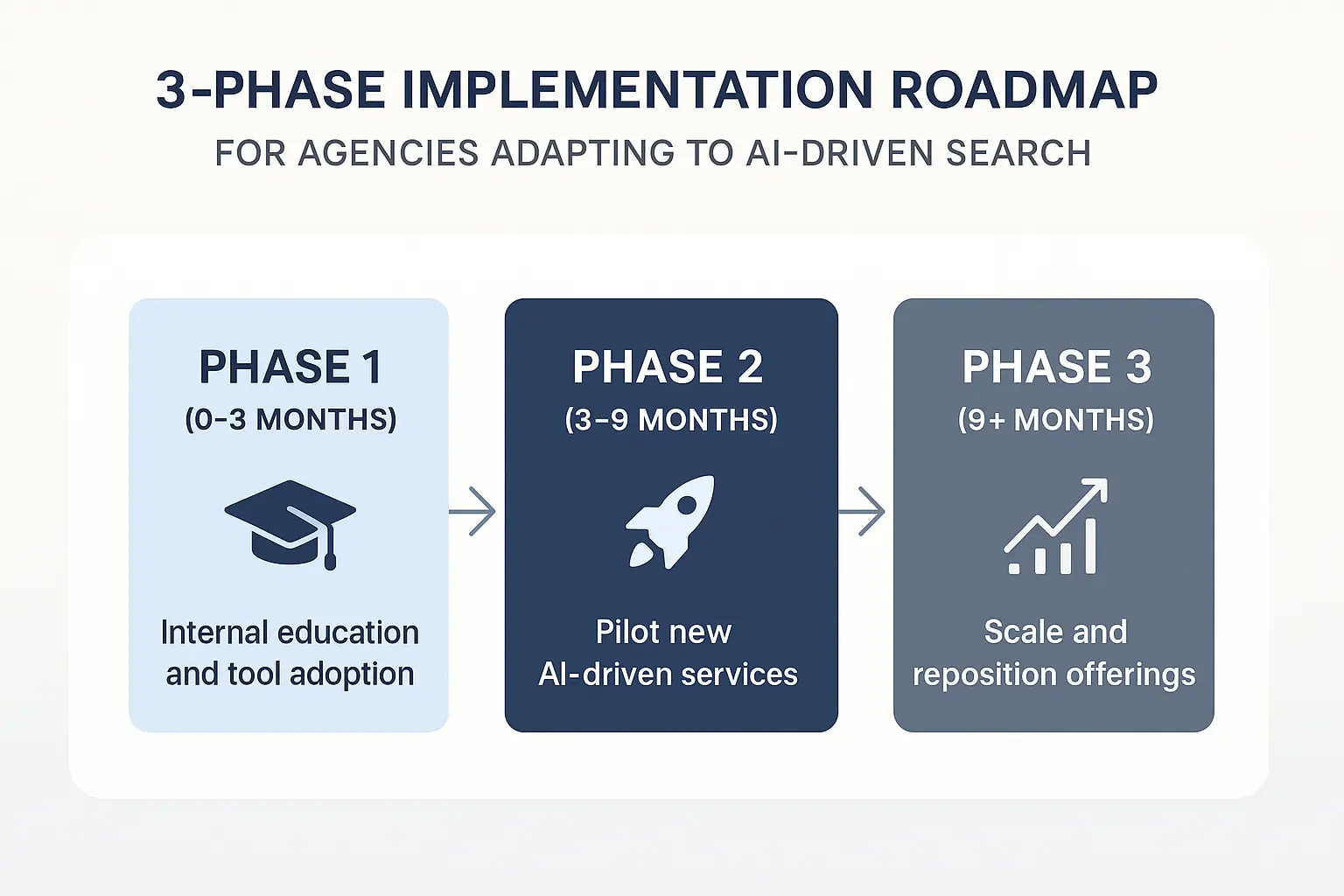
Frequently Asked Questions
Will AI make our agency’s core services obsolete?
No, but it will change them. AI will automate tasks, but it cannot replace strategy, creativity, and client relationships. The agencies that thrive will be those that use AI to handle the “what” and the “how,” freeing up their human experts to focus on the “why.” Your value shifts from pure execution to strategic counsel.
How do we educate our clients about these changes without scaring them?
Frame the conversation around opportunity, not fear. Explain that these shifts in search create new ways to connect with their ideal customers more directly. Talk about “AI-readiness” as a competitive advantage and position your agency as the expert guide who can help them navigate the transition and capture that advantage.
We’re not an SEO agency. How does this apply to us?
If you’re a web design, PPC, social, or creative agency, this is your single biggest opportunity for growth. Your clients already need and trust you. Adding a robust, AI-driven SEO offering is the most logical way to expand your services and increase retainer values. A white-label partner makes it possible to launch a new, profitable SEO service line without any in-house hiring.
Isn’t partnering with a white-label provider risky? What about client control?
This is a common concern, which is why choosing the right partner is critical. A true white-label partner operates as an invisible extension of your team. All deliverables, reports, and communication are branded as your agency. You maintain 100% control of the client relationship; the partner simply provides the execution engine in the background. It’s your brand, your strategy, and your client success story.
From Adaptation to Advantage: Your Next Move
The AI shift is not a distant event—it’s happening now. Nearly 70% of marketers are already integrating AI, with a third reporting “significant improvements” in outcomes, according to Influencer Marketing Hub.
Waiting is no longer a viable strategy. The agencies that win in this new era will be the ones that move decisively, armed with a clear strategic framework. They will get ahead of the risks by sharpening their value proposition and seize the opportunities by adding smart new capabilities.
You don’t have to build the future from scratch. By leveraging the right execution partner, you can accelerate your transformation, delight your clients with next-generation services, and build a more profitable, resilient, and future-proof agency.
Ready to power your agency’s AI evolution? Explore our solutions for agencies and see how a white-label partnership can help you scale execution invisibly.
